Analyzing Social Challenges Facing British Columbia (SOC 201)
VerifiedAdded on 2023/04/20
|14
|3766
|384
Report
AI Summary
This report addresses the social challenge of drug addiction, specifically focusing on alcoholism, in British Columbia. It begins by defining social challenges and contextualizing the issue within the province's environment, highlighting its economic stability yet grappling with social disruptions like digital technology and increasing inequality. The report then delves into the prevalence of alcoholism, citing statistics and discussing genetic, physical, emotional, and social factors contributing to addiction. It explores the biological mechanisms of addiction and the impact on the brain. The report also examines the co-occurrence of alcohol addiction with other disorders. The report then presents and evaluates two potential solutions: counseling and therapy and inpatient rehabilitation, ultimately concluding that inpatient rehabilitation may be a superior solution due to its structured and immersive approach. The assignment fulfills the requirements of a SOC 201 research assignment focusing on social problems and solutions in BC.
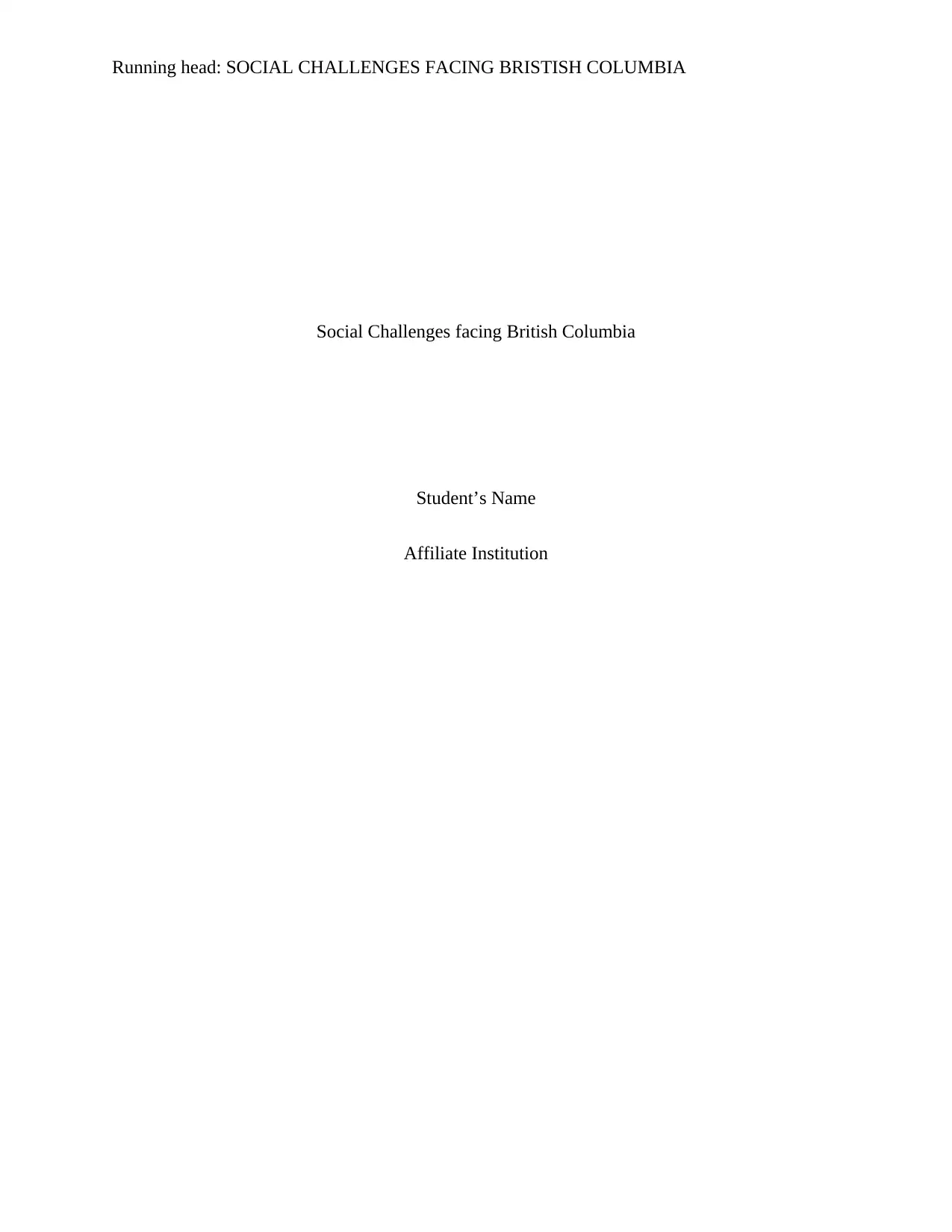
Running head: SOCIAL CHALLENGES FACING BRISTISH COLUMBIA
Social Challenges facing British Columbia
Student’s Name
Affiliate Institution
Social Challenges facing British Columbia
Student’s Name
Affiliate Institution
Paraphrase This Document
Need a fresh take? Get an instant paraphrase of this document with our AI Paraphraser
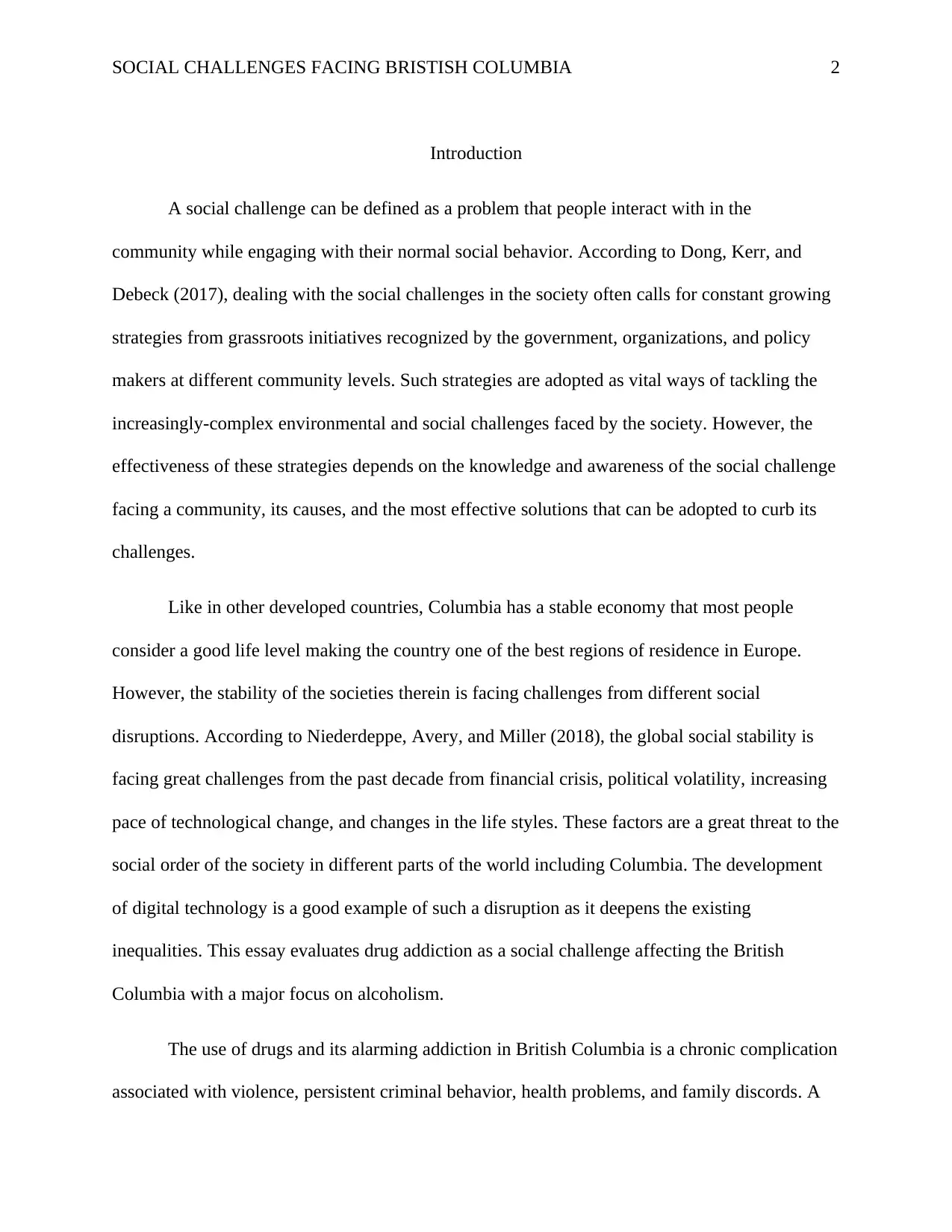
SOCIAL CHALLENGES FACING BRISTISH COLUMBIA 2
Introduction
A social challenge can be defined as a problem that people interact with in the
community while engaging with their normal social behavior. According to Dong, Kerr, and
Debeck (2017), dealing with the social challenges in the society often calls for constant growing
strategies from grassroots initiatives recognized by the government, organizations, and policy
makers at different community levels. Such strategies are adopted as vital ways of tackling the
increasingly-complex environmental and social challenges faced by the society. However, the
effectiveness of these strategies depends on the knowledge and awareness of the social challenge
facing a community, its causes, and the most effective solutions that can be adopted to curb its
challenges.
Like in other developed countries, Columbia has a stable economy that most people
consider a good life level making the country one of the best regions of residence in Europe.
However, the stability of the societies therein is facing challenges from different social
disruptions. According to Niederdeppe, Avery, and Miller (2018), the global social stability is
facing great challenges from the past decade from financial crisis, political volatility, increasing
pace of technological change, and changes in the life styles. These factors are a great threat to the
social order of the society in different parts of the world including Columbia. The development
of digital technology is a good example of such a disruption as it deepens the existing
inequalities. This essay evaluates drug addiction as a social challenge affecting the British
Columbia with a major focus on alcoholism.
The use of drugs and its alarming addiction in British Columbia is a chronic complication
associated with violence, persistent criminal behavior, health problems, and family discords. A
Introduction
A social challenge can be defined as a problem that people interact with in the
community while engaging with their normal social behavior. According to Dong, Kerr, and
Debeck (2017), dealing with the social challenges in the society often calls for constant growing
strategies from grassroots initiatives recognized by the government, organizations, and policy
makers at different community levels. Such strategies are adopted as vital ways of tackling the
increasingly-complex environmental and social challenges faced by the society. However, the
effectiveness of these strategies depends on the knowledge and awareness of the social challenge
facing a community, its causes, and the most effective solutions that can be adopted to curb its
challenges.
Like in other developed countries, Columbia has a stable economy that most people
consider a good life level making the country one of the best regions of residence in Europe.
However, the stability of the societies therein is facing challenges from different social
disruptions. According to Niederdeppe, Avery, and Miller (2018), the global social stability is
facing great challenges from the past decade from financial crisis, political volatility, increasing
pace of technological change, and changes in the life styles. These factors are a great threat to the
social order of the society in different parts of the world including Columbia. The development
of digital technology is a good example of such a disruption as it deepens the existing
inequalities. This essay evaluates drug addiction as a social challenge affecting the British
Columbia with a major focus on alcoholism.
The use of drugs and its alarming addiction in British Columbia is a chronic complication
associated with violence, persistent criminal behavior, health problems, and family discords. A
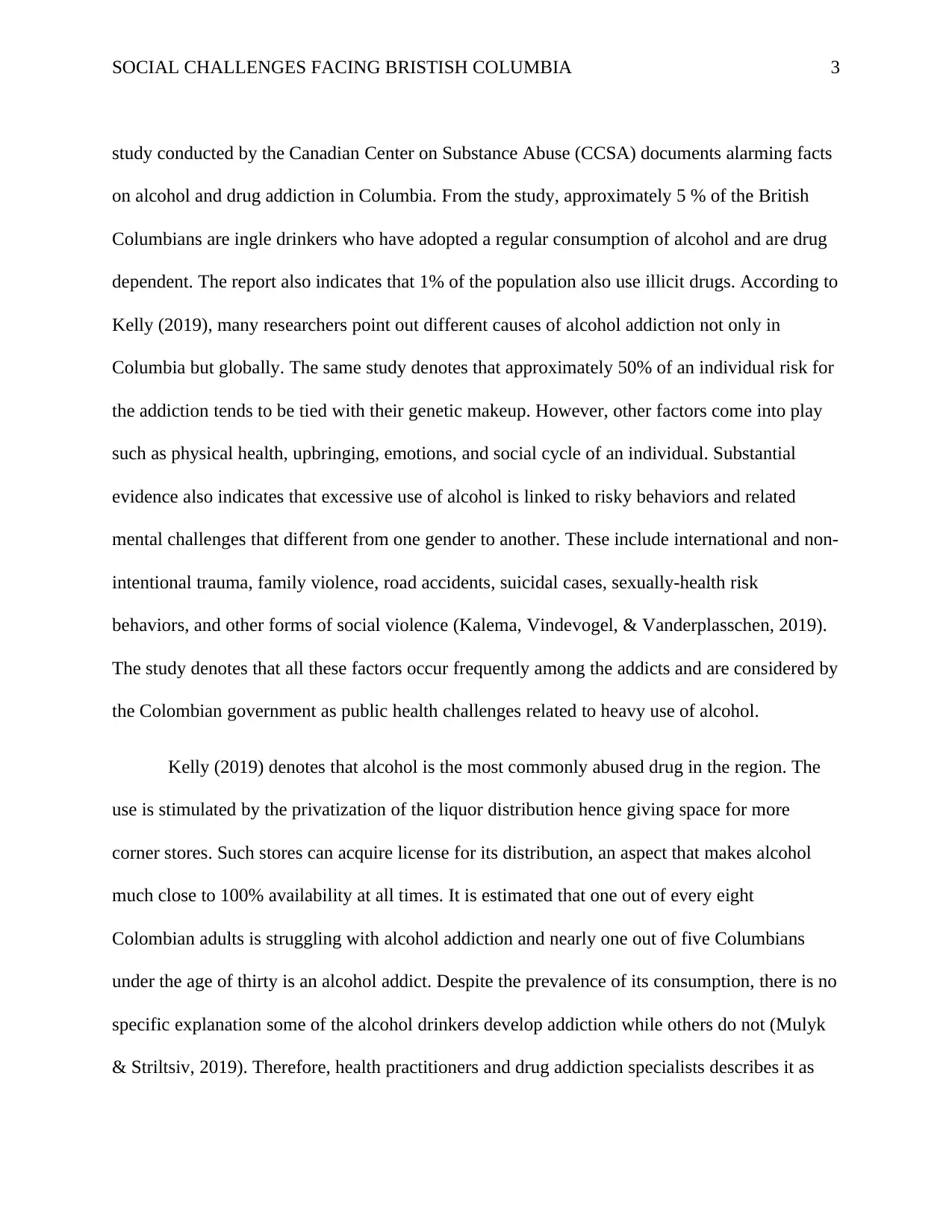
SOCIAL CHALLENGES FACING BRISTISH COLUMBIA 3
study conducted by the Canadian Center on Substance Abuse (CCSA) documents alarming facts
on alcohol and drug addiction in Columbia. From the study, approximately 5 % of the British
Columbians are ingle drinkers who have adopted a regular consumption of alcohol and are drug
dependent. The report also indicates that 1% of the population also use illicit drugs. According to
Kelly (2019), many researchers point out different causes of alcohol addiction not only in
Columbia but globally. The same study denotes that approximately 50% of an individual risk for
the addiction tends to be tied with their genetic makeup. However, other factors come into play
such as physical health, upbringing, emotions, and social cycle of an individual. Substantial
evidence also indicates that excessive use of alcohol is linked to risky behaviors and related
mental challenges that different from one gender to another. These include international and non-
intentional trauma, family violence, road accidents, suicidal cases, sexually-health risk
behaviors, and other forms of social violence (Kalema, Vindevogel, & Vanderplasschen, 2019).
The study denotes that all these factors occur frequently among the addicts and are considered by
the Colombian government as public health challenges related to heavy use of alcohol.
Kelly (2019) denotes that alcohol is the most commonly abused drug in the region. The
use is stimulated by the privatization of the liquor distribution hence giving space for more
corner stores. Such stores can acquire license for its distribution, an aspect that makes alcohol
much close to 100% availability at all times. It is estimated that one out of every eight
Colombian adults is struggling with alcohol addiction and nearly one out of five Columbians
under the age of thirty is an alcohol addict. Despite the prevalence of its consumption, there is no
specific explanation some of the alcohol drinkers develop addiction while others do not (Mulyk
& Striltsiv, 2019). Therefore, health practitioners and drug addiction specialists describes it as
study conducted by the Canadian Center on Substance Abuse (CCSA) documents alarming facts
on alcohol and drug addiction in Columbia. From the study, approximately 5 % of the British
Columbians are ingle drinkers who have adopted a regular consumption of alcohol and are drug
dependent. The report also indicates that 1% of the population also use illicit drugs. According to
Kelly (2019), many researchers point out different causes of alcohol addiction not only in
Columbia but globally. The same study denotes that approximately 50% of an individual risk for
the addiction tends to be tied with their genetic makeup. However, other factors come into play
such as physical health, upbringing, emotions, and social cycle of an individual. Substantial
evidence also indicates that excessive use of alcohol is linked to risky behaviors and related
mental challenges that different from one gender to another. These include international and non-
intentional trauma, family violence, road accidents, suicidal cases, sexually-health risk
behaviors, and other forms of social violence (Kalema, Vindevogel, & Vanderplasschen, 2019).
The study denotes that all these factors occur frequently among the addicts and are considered by
the Colombian government as public health challenges related to heavy use of alcohol.
Kelly (2019) denotes that alcohol is the most commonly abused drug in the region. The
use is stimulated by the privatization of the liquor distribution hence giving space for more
corner stores. Such stores can acquire license for its distribution, an aspect that makes alcohol
much close to 100% availability at all times. It is estimated that one out of every eight
Colombian adults is struggling with alcohol addiction and nearly one out of five Columbians
under the age of thirty is an alcohol addict. Despite the prevalence of its consumption, there is no
specific explanation some of the alcohol drinkers develop addiction while others do not (Mulyk
& Striltsiv, 2019). Therefore, health practitioners and drug addiction specialists describes it as
⊘ This is a preview!⊘
Do you want full access?
Subscribe today to unlock all pages.

Trusted by 1+ million students worldwide
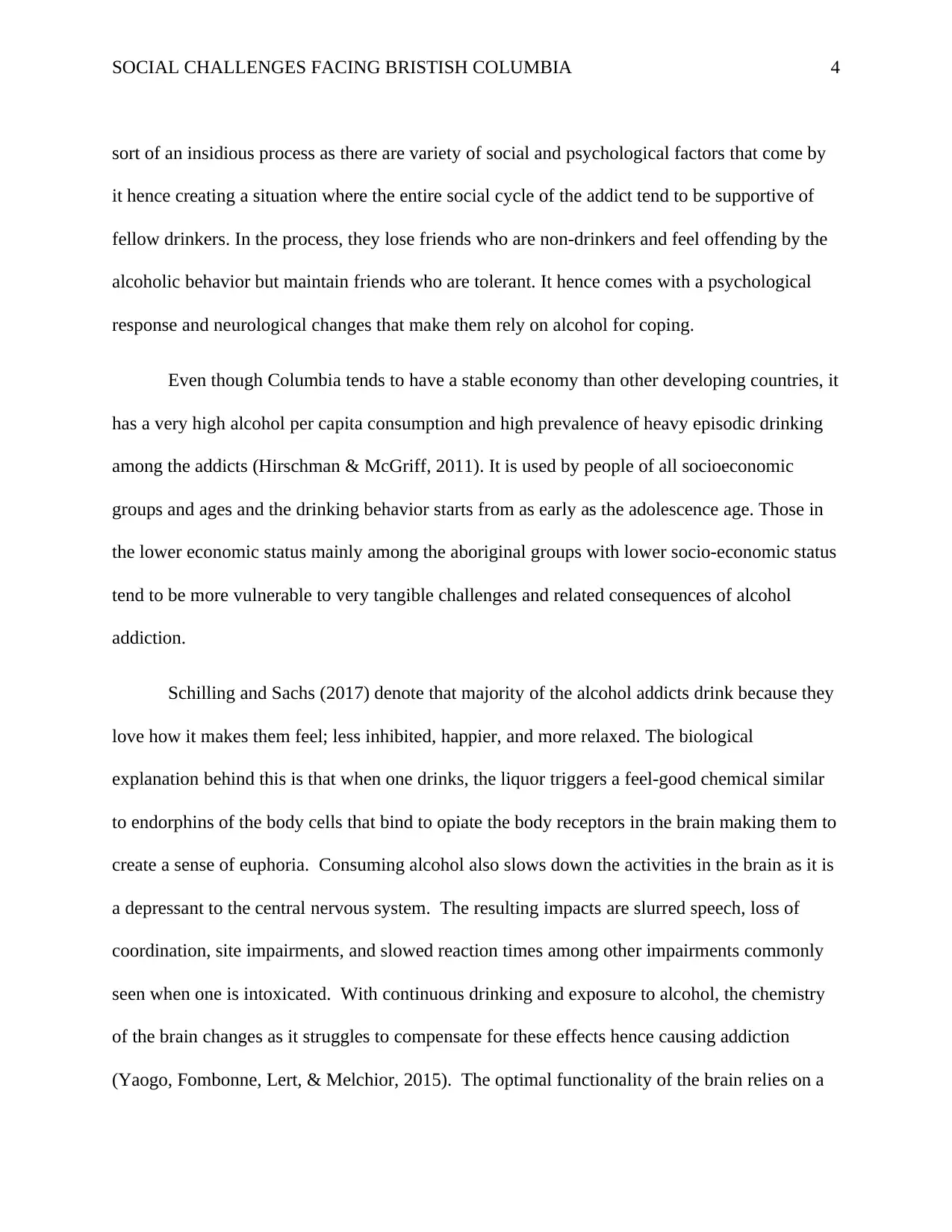
SOCIAL CHALLENGES FACING BRISTISH COLUMBIA 4
sort of an insidious process as there are variety of social and psychological factors that come by
it hence creating a situation where the entire social cycle of the addict tend to be supportive of
fellow drinkers. In the process, they lose friends who are non-drinkers and feel offending by the
alcoholic behavior but maintain friends who are tolerant. It hence comes with a psychological
response and neurological changes that make them rely on alcohol for coping.
Even though Columbia tends to have a stable economy than other developing countries, it
has a very high alcohol per capita consumption and high prevalence of heavy episodic drinking
among the addicts (Hirschman & McGriff, 2011). It is used by people of all socioeconomic
groups and ages and the drinking behavior starts from as early as the adolescence age. Those in
the lower economic status mainly among the aboriginal groups with lower socio-economic status
tend to be more vulnerable to very tangible challenges and related consequences of alcohol
addiction.
Schilling and Sachs (2017) denote that majority of the alcohol addicts drink because they
love how it makes them feel; less inhibited, happier, and more relaxed. The biological
explanation behind this is that when one drinks, the liquor triggers a feel-good chemical similar
to endorphins of the body cells that bind to opiate the body receptors in the brain making them to
create a sense of euphoria. Consuming alcohol also slows down the activities in the brain as it is
a depressant to the central nervous system. The resulting impacts are slurred speech, loss of
coordination, site impairments, and slowed reaction times among other impairments commonly
seen when one is intoxicated. With continuous drinking and exposure to alcohol, the chemistry
of the brain changes as it struggles to compensate for these effects hence causing addiction
(Yaogo, Fombonne, Lert, & Melchior, 2015). The optimal functionality of the brain relies on a
sort of an insidious process as there are variety of social and psychological factors that come by
it hence creating a situation where the entire social cycle of the addict tend to be supportive of
fellow drinkers. In the process, they lose friends who are non-drinkers and feel offending by the
alcoholic behavior but maintain friends who are tolerant. It hence comes with a psychological
response and neurological changes that make them rely on alcohol for coping.
Even though Columbia tends to have a stable economy than other developing countries, it
has a very high alcohol per capita consumption and high prevalence of heavy episodic drinking
among the addicts (Hirschman & McGriff, 2011). It is used by people of all socioeconomic
groups and ages and the drinking behavior starts from as early as the adolescence age. Those in
the lower economic status mainly among the aboriginal groups with lower socio-economic status
tend to be more vulnerable to very tangible challenges and related consequences of alcohol
addiction.
Schilling and Sachs (2017) denote that majority of the alcohol addicts drink because they
love how it makes them feel; less inhibited, happier, and more relaxed. The biological
explanation behind this is that when one drinks, the liquor triggers a feel-good chemical similar
to endorphins of the body cells that bind to opiate the body receptors in the brain making them to
create a sense of euphoria. Consuming alcohol also slows down the activities in the brain as it is
a depressant to the central nervous system. The resulting impacts are slurred speech, loss of
coordination, site impairments, and slowed reaction times among other impairments commonly
seen when one is intoxicated. With continuous drinking and exposure to alcohol, the chemistry
of the brain changes as it struggles to compensate for these effects hence causing addiction
(Yaogo, Fombonne, Lert, & Melchior, 2015). The optimal functionality of the brain relies on a
Paraphrase This Document
Need a fresh take? Get an instant paraphrase of this document with our AI Paraphraser
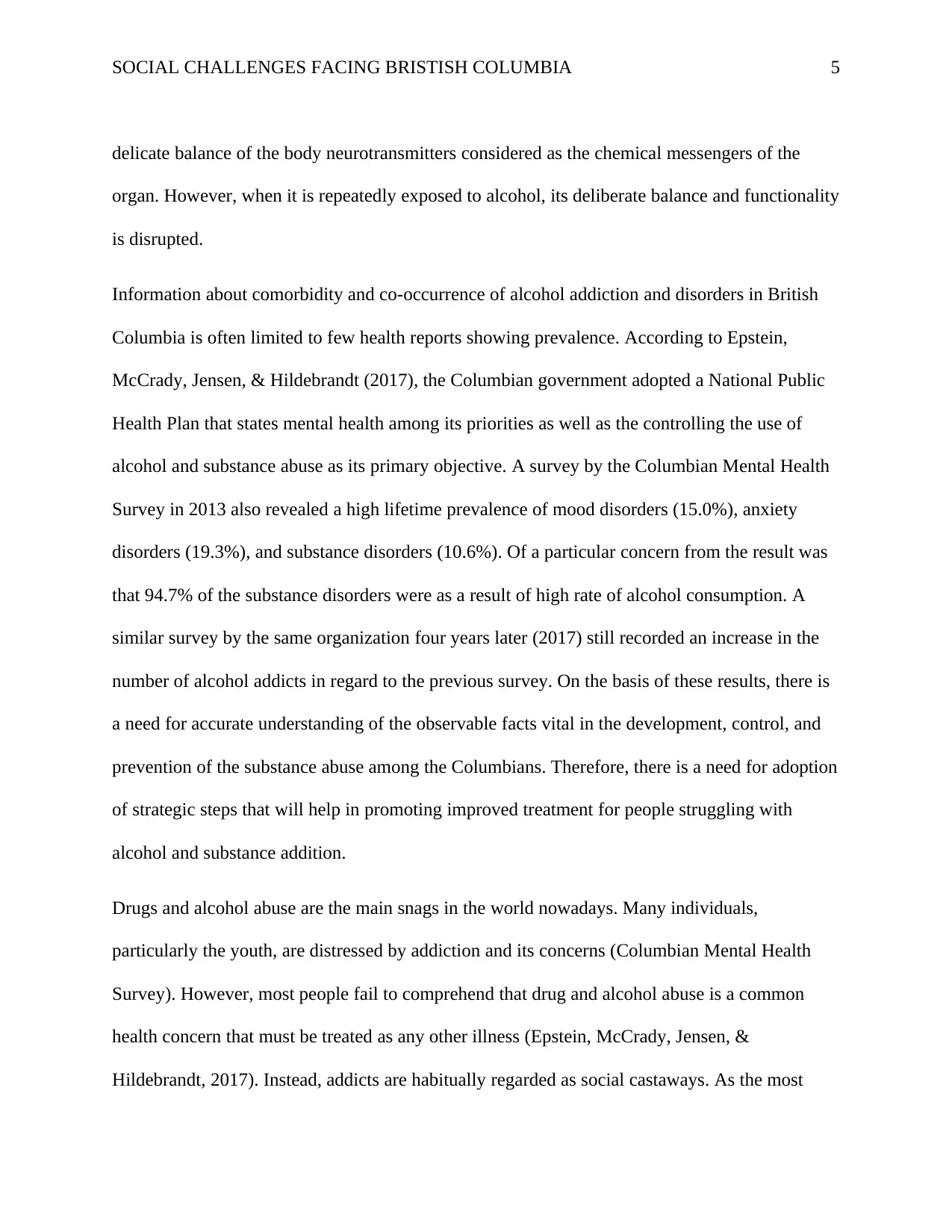
SOCIAL CHALLENGES FACING BRISTISH COLUMBIA 5
delicate balance of the body neurotransmitters considered as the chemical messengers of the
organ. However, when it is repeatedly exposed to alcohol, its deliberate balance and functionality
is disrupted.
Information about comorbidity and co-occurrence of alcohol addiction and disorders in British
Columbia is often limited to few health reports showing prevalence. According to Epstein,
McCrady, Jensen, & Hildebrandt (2017), the Columbian government adopted a National Public
Health Plan that states mental health among its priorities as well as the controlling the use of
alcohol and substance abuse as its primary objective. A survey by the Columbian Mental Health
Survey in 2013 also revealed a high lifetime prevalence of mood disorders (15.0%), anxiety
disorders (19.3%), and substance disorders (10.6%). Of a particular concern from the result was
that 94.7% of the substance disorders were as a result of high rate of alcohol consumption. A
similar survey by the same organization four years later (2017) still recorded an increase in the
number of alcohol addicts in regard to the previous survey. On the basis of these results, there is
a need for accurate understanding of the observable facts vital in the development, control, and
prevention of the substance abuse among the Columbians. Therefore, there is a need for adoption
of strategic steps that will help in promoting improved treatment for people struggling with
alcohol and substance addition.
Drugs and alcohol abuse are the main snags in the world nowadays. Many individuals,
particularly the youth, are distressed by addiction and its concerns (Columbian Mental Health
Survey). However, most people fail to comprehend that drug and alcohol abuse is a common
health concern that must be treated as any other illness (Epstein, McCrady, Jensen, &
Hildebrandt, 2017). Instead, addicts are habitually regarded as social castaways. As the most
delicate balance of the body neurotransmitters considered as the chemical messengers of the
organ. However, when it is repeatedly exposed to alcohol, its deliberate balance and functionality
is disrupted.
Information about comorbidity and co-occurrence of alcohol addiction and disorders in British
Columbia is often limited to few health reports showing prevalence. According to Epstein,
McCrady, Jensen, & Hildebrandt (2017), the Columbian government adopted a National Public
Health Plan that states mental health among its priorities as well as the controlling the use of
alcohol and substance abuse as its primary objective. A survey by the Columbian Mental Health
Survey in 2013 also revealed a high lifetime prevalence of mood disorders (15.0%), anxiety
disorders (19.3%), and substance disorders (10.6%). Of a particular concern from the result was
that 94.7% of the substance disorders were as a result of high rate of alcohol consumption. A
similar survey by the same organization four years later (2017) still recorded an increase in the
number of alcohol addicts in regard to the previous survey. On the basis of these results, there is
a need for accurate understanding of the observable facts vital in the development, control, and
prevention of the substance abuse among the Columbians. Therefore, there is a need for adoption
of strategic steps that will help in promoting improved treatment for people struggling with
alcohol and substance addition.
Drugs and alcohol abuse are the main snags in the world nowadays. Many individuals,
particularly the youth, are distressed by addiction and its concerns (Columbian Mental Health
Survey). However, most people fail to comprehend that drug and alcohol abuse is a common
health concern that must be treated as any other illness (Epstein, McCrady, Jensen, &
Hildebrandt, 2017). Instead, addicts are habitually regarded as social castaways. As the most
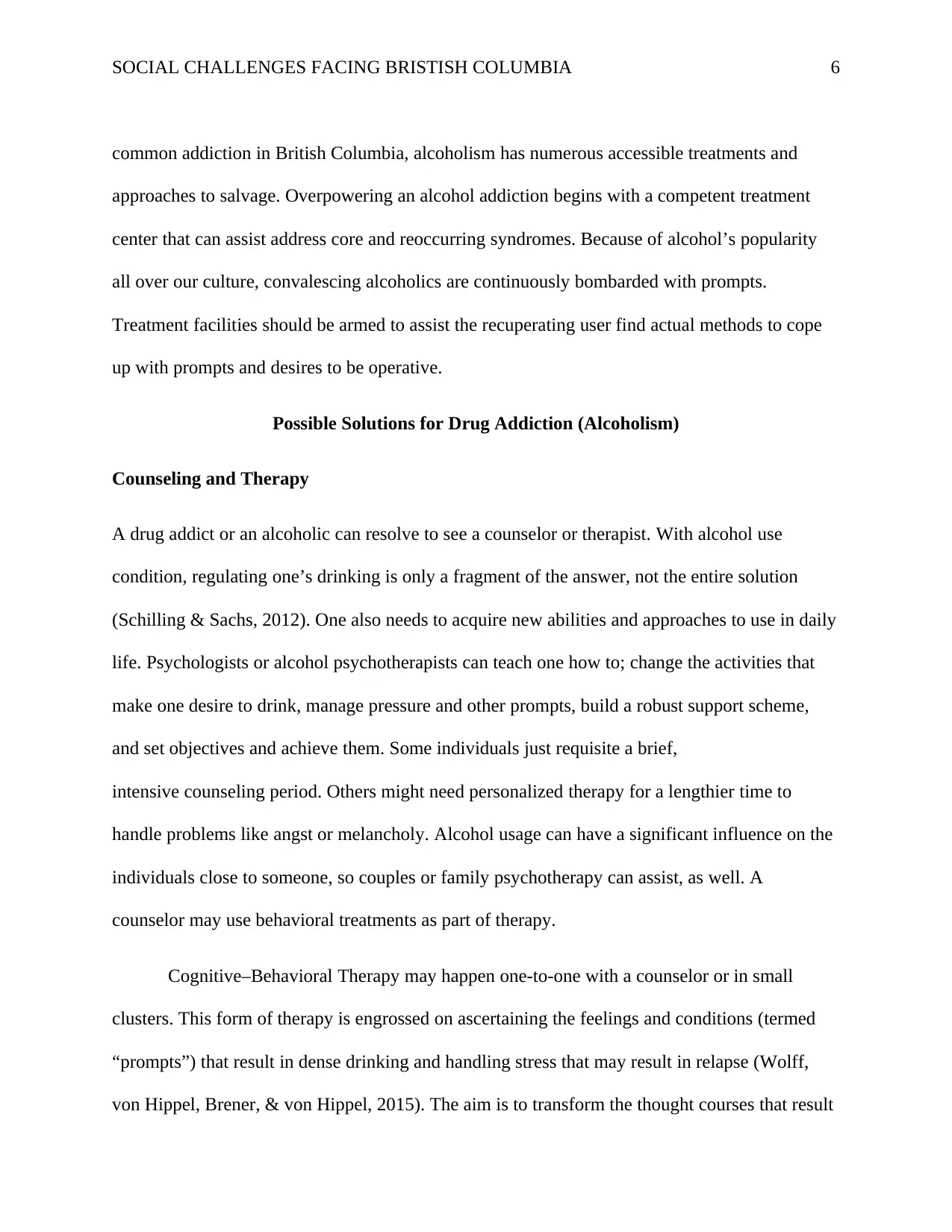
SOCIAL CHALLENGES FACING BRISTISH COLUMBIA 6
common addiction in British Columbia, alcoholism has numerous accessible treatments and
approaches to salvage. Overpowering an alcohol addiction begins with a competent treatment
center that can assist address core and reoccurring syndromes. Because of alcohol’s popularity
all over our culture, convalescing alcoholics are continuously bombarded with prompts.
Treatment facilities should be armed to assist the recuperating user find actual methods to cope
up with prompts and desires to be operative.
Possible Solutions for Drug Addiction (Alcoholism)
Counseling and Therapy
A drug addict or an alcoholic can resolve to see a counselor or therapist. With alcohol use
condition, regulating one’s drinking is only a fragment of the answer, not the entire solution
(Schilling & Sachs, 2012). One also needs to acquire new abilities and approaches to use in daily
life. Psychologists or alcohol psychotherapists can teach one how to; change the activities that
make one desire to drink, manage pressure and other prompts, build a robust support scheme,
and set objectives and achieve them. Some individuals just requisite a brief,
intensive counseling period. Others might need personalized therapy for a lengthier time to
handle problems like angst or melancholy. Alcohol usage can have a significant influence on the
individuals close to someone, so couples or family psychotherapy can assist, as well. A
counselor may use behavioral treatments as part of therapy.
Cognitive–Behavioral Therapy may happen one-to-one with a counselor or in small
clusters. This form of therapy is engrossed on ascertaining the feelings and conditions (termed
“prompts”) that result in dense drinking and handling stress that may result in relapse (Wolff,
von Hippel, Brener, & von Hippel, 2015). The aim is to transform the thought courses that result
common addiction in British Columbia, alcoholism has numerous accessible treatments and
approaches to salvage. Overpowering an alcohol addiction begins with a competent treatment
center that can assist address core and reoccurring syndromes. Because of alcohol’s popularity
all over our culture, convalescing alcoholics are continuously bombarded with prompts.
Treatment facilities should be armed to assist the recuperating user find actual methods to cope
up with prompts and desires to be operative.
Possible Solutions for Drug Addiction (Alcoholism)
Counseling and Therapy
A drug addict or an alcoholic can resolve to see a counselor or therapist. With alcohol use
condition, regulating one’s drinking is only a fragment of the answer, not the entire solution
(Schilling & Sachs, 2012). One also needs to acquire new abilities and approaches to use in daily
life. Psychologists or alcohol psychotherapists can teach one how to; change the activities that
make one desire to drink, manage pressure and other prompts, build a robust support scheme,
and set objectives and achieve them. Some individuals just requisite a brief,
intensive counseling period. Others might need personalized therapy for a lengthier time to
handle problems like angst or melancholy. Alcohol usage can have a significant influence on the
individuals close to someone, so couples or family psychotherapy can assist, as well. A
counselor may use behavioral treatments as part of therapy.
Cognitive–Behavioral Therapy may happen one-to-one with a counselor or in small
clusters. This form of therapy is engrossed on ascertaining the feelings and conditions (termed
“prompts”) that result in dense drinking and handling stress that may result in relapse (Wolff,
von Hippel, Brener, & von Hippel, 2015). The aim is to transform the thought courses that result
⊘ This is a preview!⊘
Do you want full access?
Subscribe today to unlock all pages.

Trusted by 1+ million students worldwide
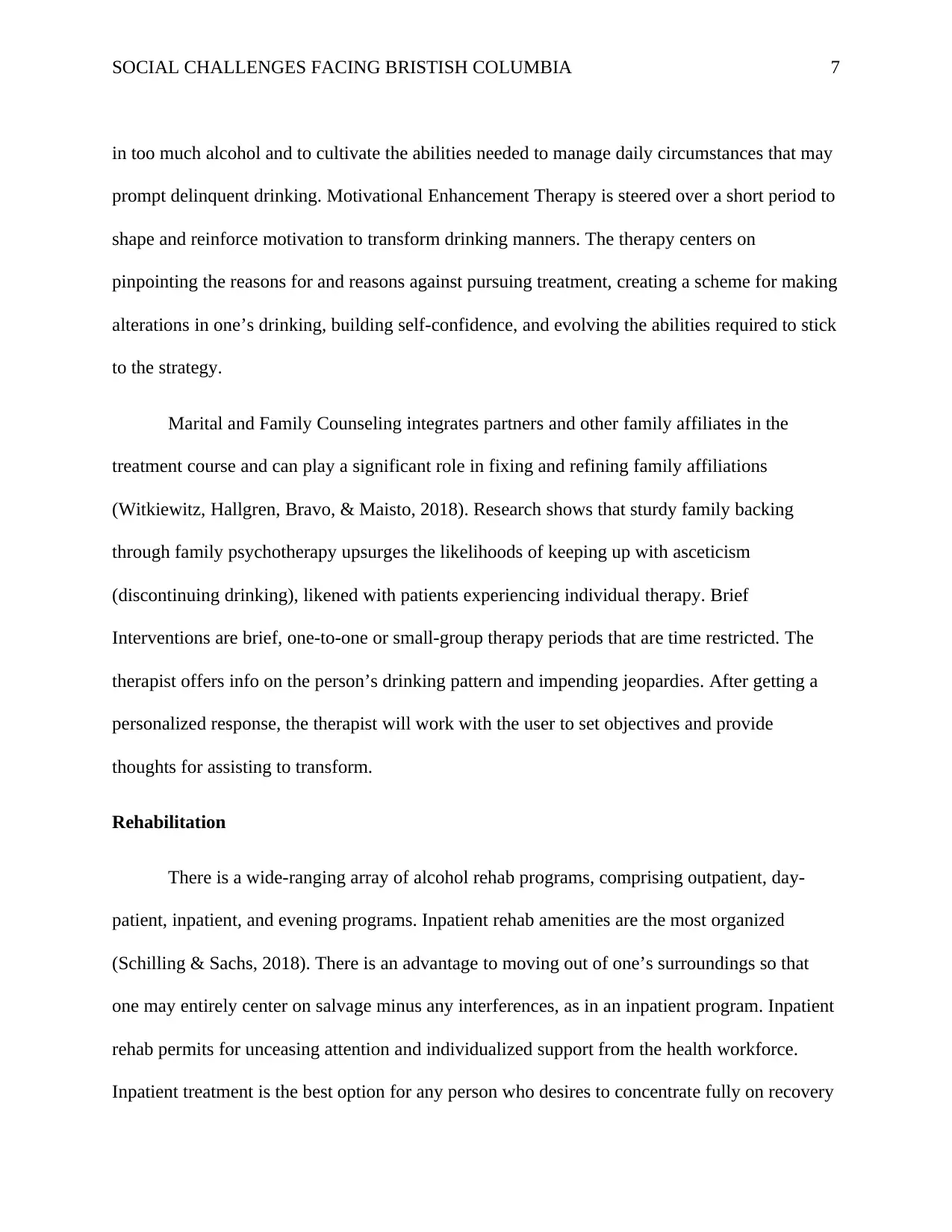
SOCIAL CHALLENGES FACING BRISTISH COLUMBIA 7
in too much alcohol and to cultivate the abilities needed to manage daily circumstances that may
prompt delinquent drinking. Motivational Enhancement Therapy is steered over a short period to
shape and reinforce motivation to transform drinking manners. The therapy centers on
pinpointing the reasons for and reasons against pursuing treatment, creating a scheme for making
alterations in one’s drinking, building self-confidence, and evolving the abilities required to stick
to the strategy.
Marital and Family Counseling integrates partners and other family affiliates in the
treatment course and can play a significant role in fixing and refining family affiliations
(Witkiewitz, Hallgren, Bravo, & Maisto, 2018). Research shows that sturdy family backing
through family psychotherapy upsurges the likelihoods of keeping up with asceticism
(discontinuing drinking), likened with patients experiencing individual therapy. Brief
Interventions are brief, one-to-one or small-group therapy periods that are time restricted. The
therapist offers info on the person’s drinking pattern and impending jeopardies. After getting a
personalized response, the therapist will work with the user to set objectives and provide
thoughts for assisting to transform.
Rehabilitation
There is a wide-ranging array of alcohol rehab programs, comprising outpatient, day-
patient, inpatient, and evening programs. Inpatient rehab amenities are the most organized
(Schilling & Sachs, 2018). There is an advantage to moving out of one’s surroundings so that
one may entirely center on salvage minus any interferences, as in an inpatient program. Inpatient
rehab permits for unceasing attention and individualized support from the health workforce.
Inpatient treatment is the best option for any person who desires to concentrate fully on recovery
in too much alcohol and to cultivate the abilities needed to manage daily circumstances that may
prompt delinquent drinking. Motivational Enhancement Therapy is steered over a short period to
shape and reinforce motivation to transform drinking manners. The therapy centers on
pinpointing the reasons for and reasons against pursuing treatment, creating a scheme for making
alterations in one’s drinking, building self-confidence, and evolving the abilities required to stick
to the strategy.
Marital and Family Counseling integrates partners and other family affiliates in the
treatment course and can play a significant role in fixing and refining family affiliations
(Witkiewitz, Hallgren, Bravo, & Maisto, 2018). Research shows that sturdy family backing
through family psychotherapy upsurges the likelihoods of keeping up with asceticism
(discontinuing drinking), likened with patients experiencing individual therapy. Brief
Interventions are brief, one-to-one or small-group therapy periods that are time restricted. The
therapist offers info on the person’s drinking pattern and impending jeopardies. After getting a
personalized response, the therapist will work with the user to set objectives and provide
thoughts for assisting to transform.
Rehabilitation
There is a wide-ranging array of alcohol rehab programs, comprising outpatient, day-
patient, inpatient, and evening programs. Inpatient rehab amenities are the most organized
(Schilling & Sachs, 2018). There is an advantage to moving out of one’s surroundings so that
one may entirely center on salvage minus any interferences, as in an inpatient program. Inpatient
rehab permits for unceasing attention and individualized support from the health workforce.
Inpatient treatment is the best option for any person who desires to concentrate fully on recovery
Paraphrase This Document
Need a fresh take? Get an instant paraphrase of this document with our AI Paraphraser
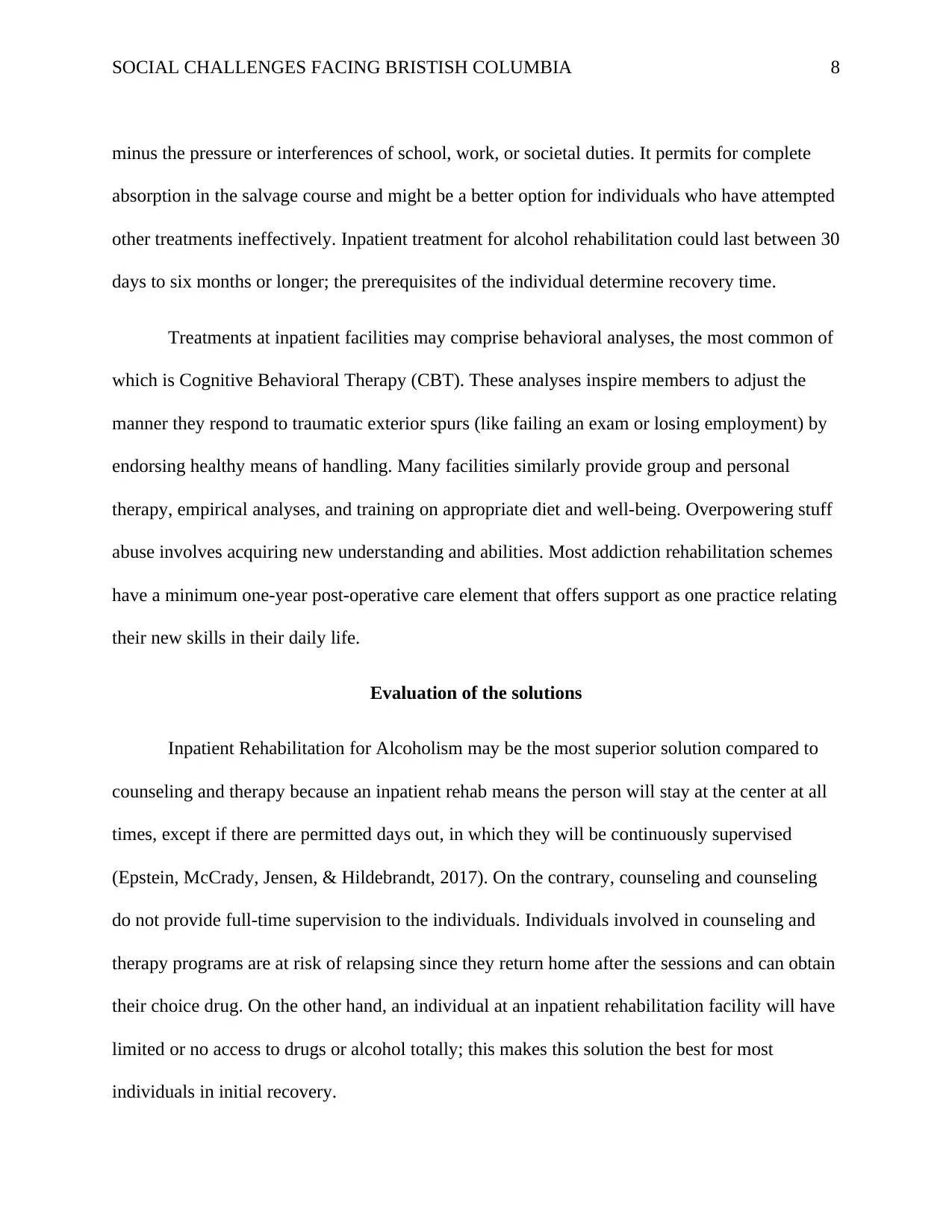
SOCIAL CHALLENGES FACING BRISTISH COLUMBIA 8
minus the pressure or interferences of school, work, or societal duties. It permits for complete
absorption in the salvage course and might be a better option for individuals who have attempted
other treatments ineffectively. Inpatient treatment for alcohol rehabilitation could last between 30
days to six months or longer; the prerequisites of the individual determine recovery time.
Treatments at inpatient facilities may comprise behavioral analyses, the most common of
which is Cognitive Behavioral Therapy (CBT). These analyses inspire members to adjust the
manner they respond to traumatic exterior spurs (like failing an exam or losing employment) by
endorsing healthy means of handling. Many facilities similarly provide group and personal
therapy, empirical analyses, and training on appropriate diet and well-being. Overpowering stuff
abuse involves acquiring new understanding and abilities. Most addiction rehabilitation schemes
have a minimum one-year post-operative care element that offers support as one practice relating
their new skills in their daily life.
Evaluation of the solutions
Inpatient Rehabilitation for Alcoholism may be the most superior solution compared to
counseling and therapy because an inpatient rehab means the person will stay at the center at all
times, except if there are permitted days out, in which they will be continuously supervised
(Epstein, McCrady, Jensen, & Hildebrandt, 2017). On the contrary, counseling and counseling
do not provide full-time supervision to the individuals. Individuals involved in counseling and
therapy programs are at risk of relapsing since they return home after the sessions and can obtain
their choice drug. On the other hand, an individual at an inpatient rehabilitation facility will have
limited or no access to drugs or alcohol totally; this makes this solution the best for most
individuals in initial recovery.
minus the pressure or interferences of school, work, or societal duties. It permits for complete
absorption in the salvage course and might be a better option for individuals who have attempted
other treatments ineffectively. Inpatient treatment for alcohol rehabilitation could last between 30
days to six months or longer; the prerequisites of the individual determine recovery time.
Treatments at inpatient facilities may comprise behavioral analyses, the most common of
which is Cognitive Behavioral Therapy (CBT). These analyses inspire members to adjust the
manner they respond to traumatic exterior spurs (like failing an exam or losing employment) by
endorsing healthy means of handling. Many facilities similarly provide group and personal
therapy, empirical analyses, and training on appropriate diet and well-being. Overpowering stuff
abuse involves acquiring new understanding and abilities. Most addiction rehabilitation schemes
have a minimum one-year post-operative care element that offers support as one practice relating
their new skills in their daily life.
Evaluation of the solutions
Inpatient Rehabilitation for Alcoholism may be the most superior solution compared to
counseling and therapy because an inpatient rehab means the person will stay at the center at all
times, except if there are permitted days out, in which they will be continuously supervised
(Epstein, McCrady, Jensen, & Hildebrandt, 2017). On the contrary, counseling and counseling
do not provide full-time supervision to the individuals. Individuals involved in counseling and
therapy programs are at risk of relapsing since they return home after the sessions and can obtain
their choice drug. On the other hand, an individual at an inpatient rehabilitation facility will have
limited or no access to drugs or alcohol totally; this makes this solution the best for most
individuals in initial recovery.
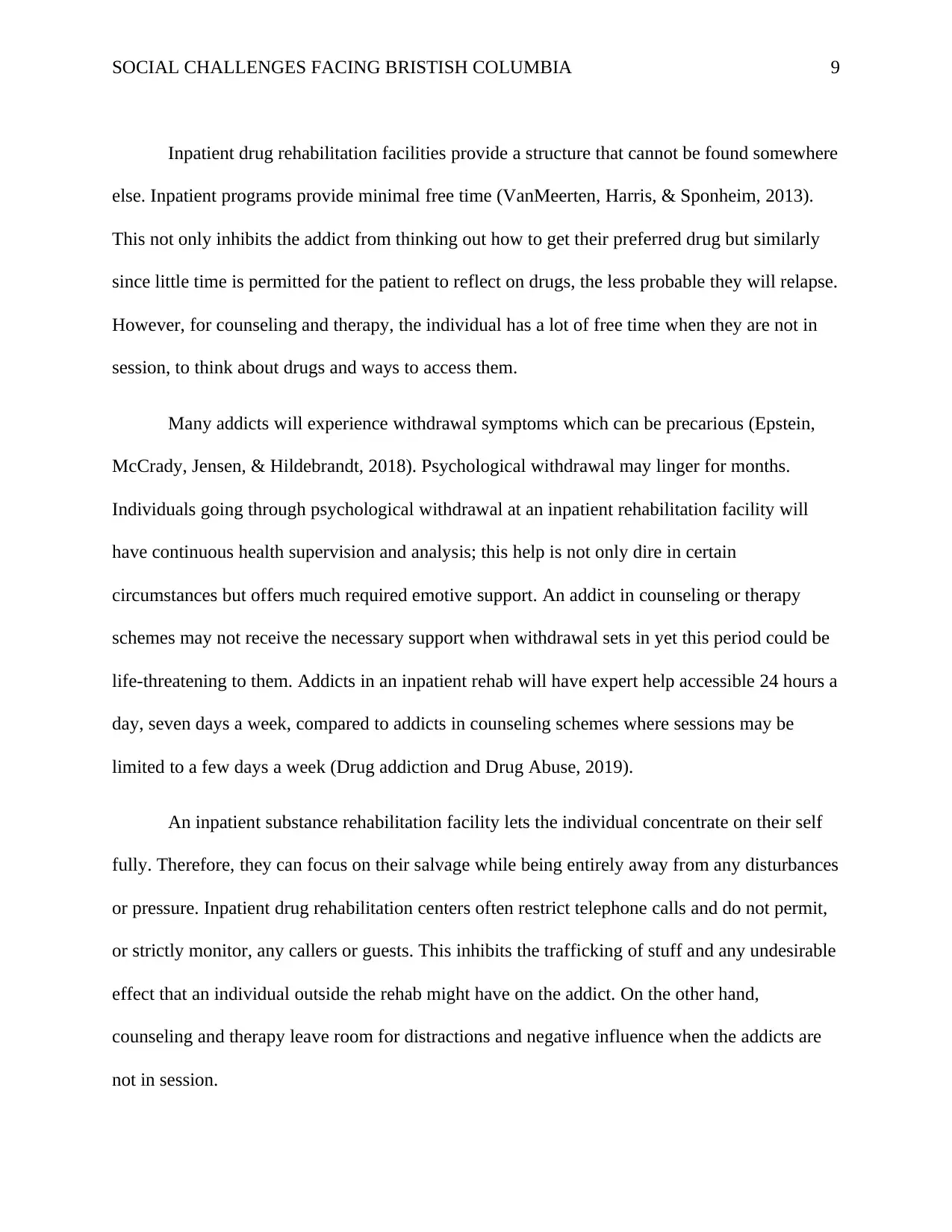
SOCIAL CHALLENGES FACING BRISTISH COLUMBIA 9
Inpatient drug rehabilitation facilities provide a structure that cannot be found somewhere
else. Inpatient programs provide minimal free time (VanMeerten, Harris, & Sponheim, 2013).
This not only inhibits the addict from thinking out how to get their preferred drug but similarly
since little time is permitted for the patient to reflect on drugs, the less probable they will relapse.
However, for counseling and therapy, the individual has a lot of free time when they are not in
session, to think about drugs and ways to access them.
Many addicts will experience withdrawal symptoms which can be precarious (Epstein,
McCrady, Jensen, & Hildebrandt, 2018). Psychological withdrawal may linger for months.
Individuals going through psychological withdrawal at an inpatient rehabilitation facility will
have continuous health supervision and analysis; this help is not only dire in certain
circumstances but offers much required emotive support. An addict in counseling or therapy
schemes may not receive the necessary support when withdrawal sets in yet this period could be
life-threatening to them. Addicts in an inpatient rehab will have expert help accessible 24 hours a
day, seven days a week, compared to addicts in counseling schemes where sessions may be
limited to a few days a week (Drug addiction and Drug Abuse, 2019).
An inpatient substance rehabilitation facility lets the individual concentrate on their self
fully. Therefore, they can focus on their salvage while being entirely away from any disturbances
or pressure. Inpatient drug rehabilitation centers often restrict telephone calls and do not permit,
or strictly monitor, any callers or guests. This inhibits the trafficking of stuff and any undesirable
effect that an individual outside the rehab might have on the addict. On the other hand,
counseling and therapy leave room for distractions and negative influence when the addicts are
not in session.
Inpatient drug rehabilitation facilities provide a structure that cannot be found somewhere
else. Inpatient programs provide minimal free time (VanMeerten, Harris, & Sponheim, 2013).
This not only inhibits the addict from thinking out how to get their preferred drug but similarly
since little time is permitted for the patient to reflect on drugs, the less probable they will relapse.
However, for counseling and therapy, the individual has a lot of free time when they are not in
session, to think about drugs and ways to access them.
Many addicts will experience withdrawal symptoms which can be precarious (Epstein,
McCrady, Jensen, & Hildebrandt, 2018). Psychological withdrawal may linger for months.
Individuals going through psychological withdrawal at an inpatient rehabilitation facility will
have continuous health supervision and analysis; this help is not only dire in certain
circumstances but offers much required emotive support. An addict in counseling or therapy
schemes may not receive the necessary support when withdrawal sets in yet this period could be
life-threatening to them. Addicts in an inpatient rehab will have expert help accessible 24 hours a
day, seven days a week, compared to addicts in counseling schemes where sessions may be
limited to a few days a week (Drug addiction and Drug Abuse, 2019).
An inpatient substance rehabilitation facility lets the individual concentrate on their self
fully. Therefore, they can focus on their salvage while being entirely away from any disturbances
or pressure. Inpatient drug rehabilitation centers often restrict telephone calls and do not permit,
or strictly monitor, any callers or guests. This inhibits the trafficking of stuff and any undesirable
effect that an individual outside the rehab might have on the addict. On the other hand,
counseling and therapy leave room for distractions and negative influence when the addicts are
not in session.
⊘ This is a preview!⊘
Do you want full access?
Subscribe today to unlock all pages.

Trusted by 1+ million students worldwide
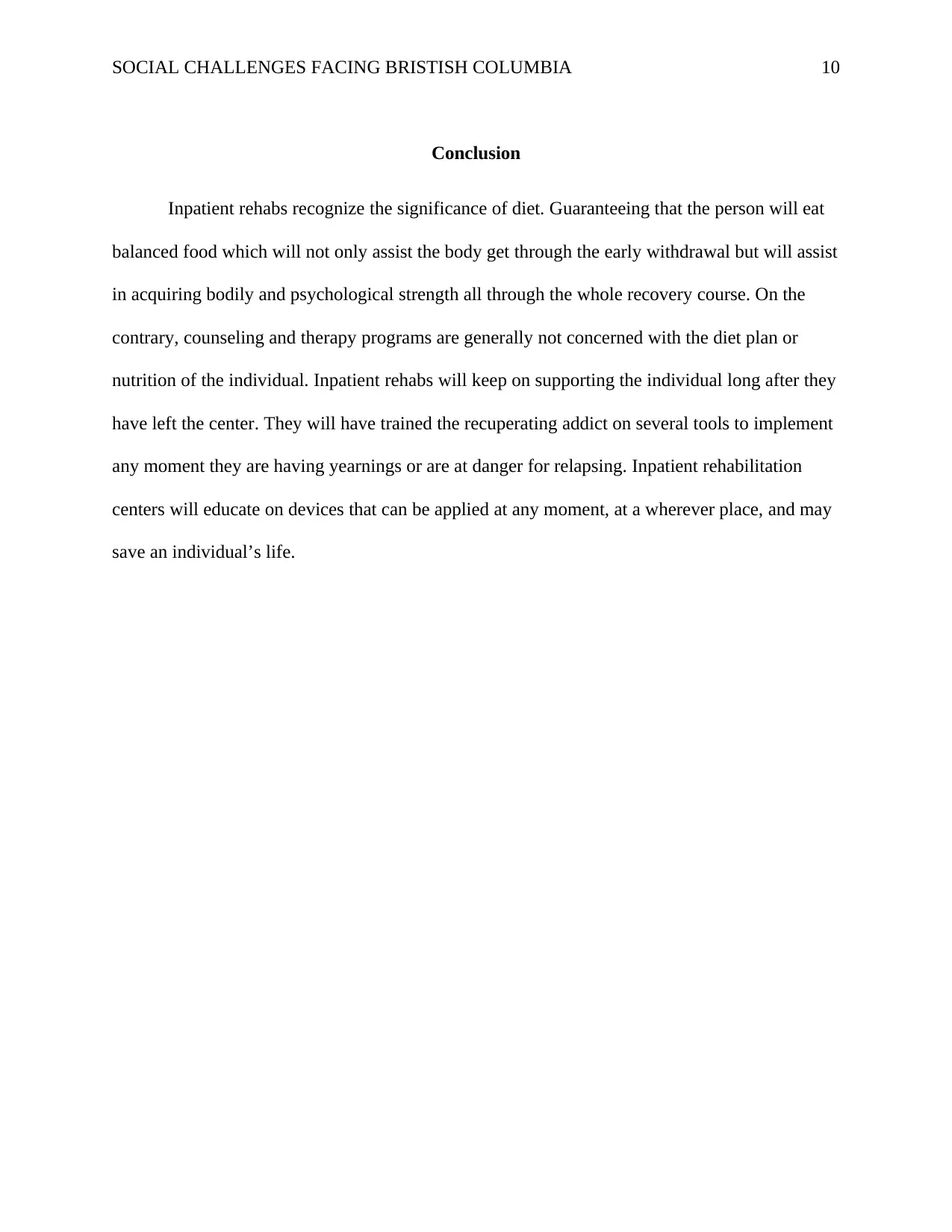
SOCIAL CHALLENGES FACING BRISTISH COLUMBIA 10
Conclusion
Inpatient rehabs recognize the significance of diet. Guaranteeing that the person will eat
balanced food which will not only assist the body get through the early withdrawal but will assist
in acquiring bodily and psychological strength all through the whole recovery course. On the
contrary, counseling and therapy programs are generally not concerned with the diet plan or
nutrition of the individual. Inpatient rehabs will keep on supporting the individual long after they
have left the center. They will have trained the recuperating addict on several tools to implement
any moment they are having yearnings or are at danger for relapsing. Inpatient rehabilitation
centers will educate on devices that can be applied at any moment, at a wherever place, and may
save an individual’s life.
Conclusion
Inpatient rehabs recognize the significance of diet. Guaranteeing that the person will eat
balanced food which will not only assist the body get through the early withdrawal but will assist
in acquiring bodily and psychological strength all through the whole recovery course. On the
contrary, counseling and therapy programs are generally not concerned with the diet plan or
nutrition of the individual. Inpatient rehabs will keep on supporting the individual long after they
have left the center. They will have trained the recuperating addict on several tools to implement
any moment they are having yearnings or are at danger for relapsing. Inpatient rehabilitation
centers will educate on devices that can be applied at any moment, at a wherever place, and may
save an individual’s life.
Paraphrase This Document
Need a fresh take? Get an instant paraphrase of this document with our AI Paraphraser
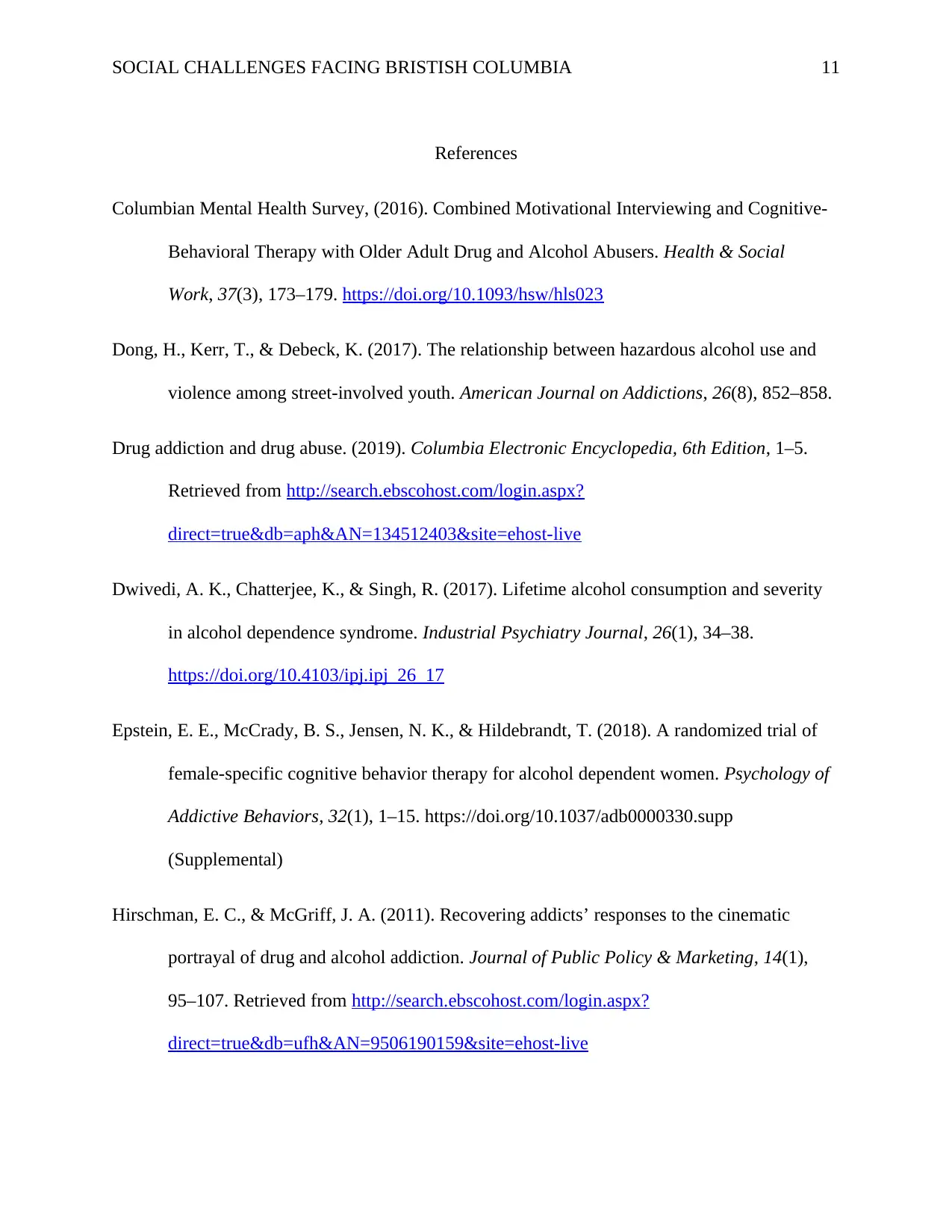
SOCIAL CHALLENGES FACING BRISTISH COLUMBIA 11
References
Columbian Mental Health Survey, (2016). Combined Motivational Interviewing and Cognitive-
Behavioral Therapy with Older Adult Drug and Alcohol Abusers. Health & Social
Work, 37(3), 173–179. https://doi.org/10.1093/hsw/hls023
Dong, H., Kerr, T., & Debeck, K. (2017). The relationship between hazardous alcohol use and
violence among street-involved youth. American Journal on Addictions, 26(8), 852–858.
Drug addiction and drug abuse. (2019). Columbia Electronic Encyclopedia, 6th Edition, 1–5.
Retrieved from http://search.ebscohost.com/login.aspx?
direct=true&db=aph&AN=134512403&site=ehost-live
Dwivedi, A. K., Chatterjee, K., & Singh, R. (2017). Lifetime alcohol consumption and severity
in alcohol dependence syndrome. Industrial Psychiatry Journal, 26(1), 34–38.
https://doi.org/10.4103/ipj.ipj_26_17
Epstein, E. E., McCrady, B. S., Jensen, N. K., & Hildebrandt, T. (2018). A randomized trial of
female-specific cognitive behavior therapy for alcohol dependent women. Psychology of
Addictive Behaviors, 32(1), 1–15. https://doi.org/10.1037/adb0000330.supp
(Supplemental)
Hirschman, E. C., & McGriff, J. A. (2011). Recovering addicts’ responses to the cinematic
portrayal of drug and alcohol addiction. Journal of Public Policy & Marketing, 14(1),
95–107. Retrieved from http://search.ebscohost.com/login.aspx?
direct=true&db=ufh&AN=9506190159&site=ehost-live
References
Columbian Mental Health Survey, (2016). Combined Motivational Interviewing and Cognitive-
Behavioral Therapy with Older Adult Drug and Alcohol Abusers. Health & Social
Work, 37(3), 173–179. https://doi.org/10.1093/hsw/hls023
Dong, H., Kerr, T., & Debeck, K. (2017). The relationship between hazardous alcohol use and
violence among street-involved youth. American Journal on Addictions, 26(8), 852–858.
Drug addiction and drug abuse. (2019). Columbia Electronic Encyclopedia, 6th Edition, 1–5.
Retrieved from http://search.ebscohost.com/login.aspx?
direct=true&db=aph&AN=134512403&site=ehost-live
Dwivedi, A. K., Chatterjee, K., & Singh, R. (2017). Lifetime alcohol consumption and severity
in alcohol dependence syndrome. Industrial Psychiatry Journal, 26(1), 34–38.
https://doi.org/10.4103/ipj.ipj_26_17
Epstein, E. E., McCrady, B. S., Jensen, N. K., & Hildebrandt, T. (2018). A randomized trial of
female-specific cognitive behavior therapy for alcohol dependent women. Psychology of
Addictive Behaviors, 32(1), 1–15. https://doi.org/10.1037/adb0000330.supp
(Supplemental)
Hirschman, E. C., & McGriff, J. A. (2011). Recovering addicts’ responses to the cinematic
portrayal of drug and alcohol addiction. Journal of Public Policy & Marketing, 14(1),
95–107. Retrieved from http://search.ebscohost.com/login.aspx?
direct=true&db=ufh&AN=9506190159&site=ehost-live
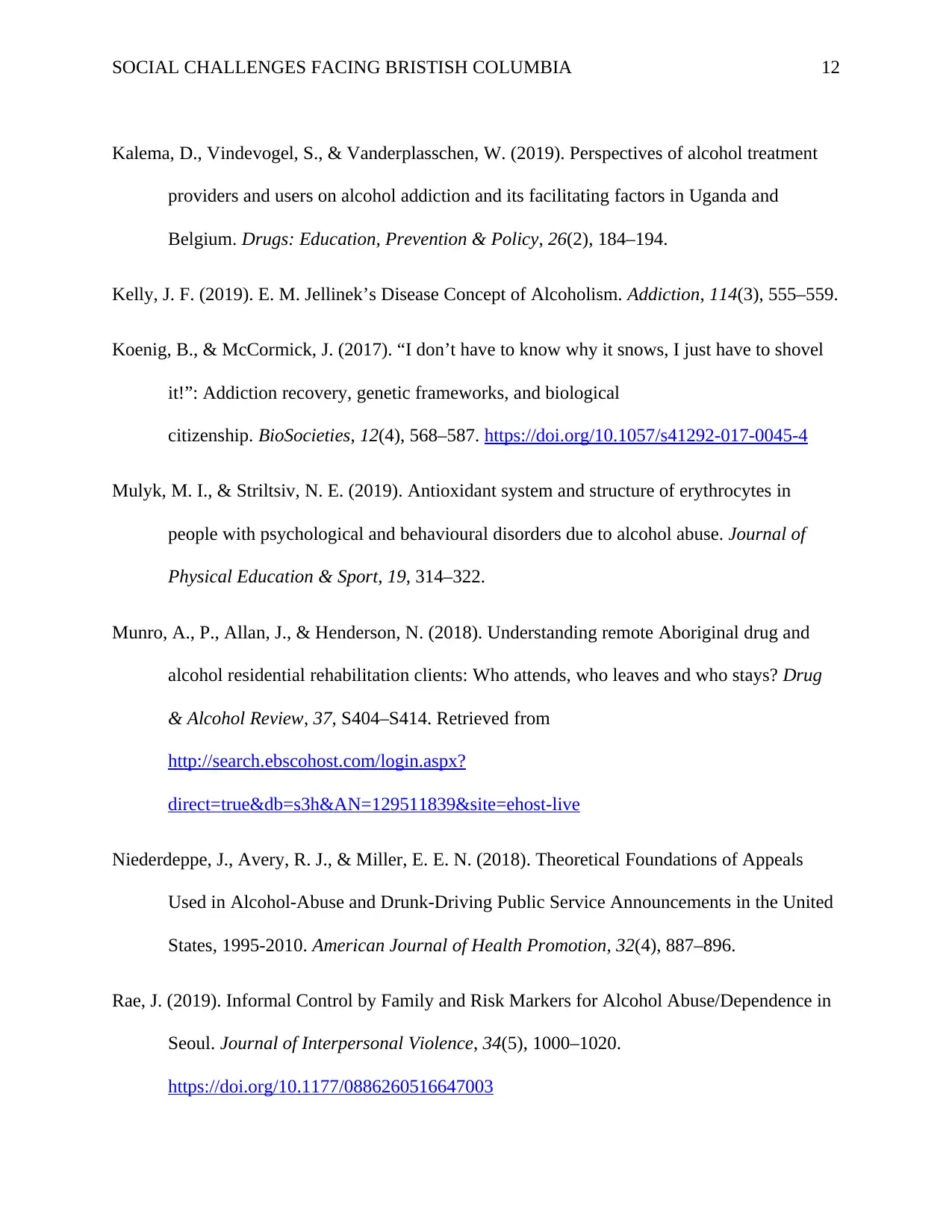
SOCIAL CHALLENGES FACING BRISTISH COLUMBIA 12
Kalema, D., Vindevogel, S., & Vanderplasschen, W. (2019). Perspectives of alcohol treatment
providers and users on alcohol addiction and its facilitating factors in Uganda and
Belgium. Drugs: Education, Prevention & Policy, 26(2), 184–194.
Kelly, J. F. (2019). E. M. Jellinek’s Disease Concept of Alcoholism. Addiction, 114(3), 555–559.
Koenig, B., & McCormick, J. (2017). “I don’t have to know why it snows, I just have to shovel
it!”: Addiction recovery, genetic frameworks, and biological
citizenship. BioSocieties, 12(4), 568–587. https://doi.org/10.1057/s41292-017-0045-4
Mulyk, M. I., & Striltsiv, N. E. (2019). Antioxidant system and structure of erythrocytes in
people with psychological and behavioural disorders due to alcohol abuse. Journal of
Physical Education & Sport, 19, 314–322.
Munro, A., P., Allan, J., & Henderson, N. (2018). Understanding remote Aboriginal drug and
alcohol residential rehabilitation clients: Who attends, who leaves and who stays? Drug
& Alcohol Review, 37, S404–S414. Retrieved from
http://search.ebscohost.com/login.aspx?
direct=true&db=s3h&AN=129511839&site=ehost-live
Niederdeppe, J., Avery, R. J., & Miller, E. E. N. (2018). Theoretical Foundations of Appeals
Used in Alcohol-Abuse and Drunk-Driving Public Service Announcements in the United
States, 1995-2010. American Journal of Health Promotion, 32(4), 887–896.
Rae, J. (2019). Informal Control by Family and Risk Markers for Alcohol Abuse/Dependence in
Seoul. Journal of Interpersonal Violence, 34(5), 1000–1020.
https://doi.org/10.1177/0886260516647003
Kalema, D., Vindevogel, S., & Vanderplasschen, W. (2019). Perspectives of alcohol treatment
providers and users on alcohol addiction and its facilitating factors in Uganda and
Belgium. Drugs: Education, Prevention & Policy, 26(2), 184–194.
Kelly, J. F. (2019). E. M. Jellinek’s Disease Concept of Alcoholism. Addiction, 114(3), 555–559.
Koenig, B., & McCormick, J. (2017). “I don’t have to know why it snows, I just have to shovel
it!”: Addiction recovery, genetic frameworks, and biological
citizenship. BioSocieties, 12(4), 568–587. https://doi.org/10.1057/s41292-017-0045-4
Mulyk, M. I., & Striltsiv, N. E. (2019). Antioxidant system and structure of erythrocytes in
people with psychological and behavioural disorders due to alcohol abuse. Journal of
Physical Education & Sport, 19, 314–322.
Munro, A., P., Allan, J., & Henderson, N. (2018). Understanding remote Aboriginal drug and
alcohol residential rehabilitation clients: Who attends, who leaves and who stays? Drug
& Alcohol Review, 37, S404–S414. Retrieved from
http://search.ebscohost.com/login.aspx?
direct=true&db=s3h&AN=129511839&site=ehost-live
Niederdeppe, J., Avery, R. J., & Miller, E. E. N. (2018). Theoretical Foundations of Appeals
Used in Alcohol-Abuse and Drunk-Driving Public Service Announcements in the United
States, 1995-2010. American Journal of Health Promotion, 32(4), 887–896.
Rae, J. (2019). Informal Control by Family and Risk Markers for Alcohol Abuse/Dependence in
Seoul. Journal of Interpersonal Violence, 34(5), 1000–1020.
https://doi.org/10.1177/0886260516647003
⊘ This is a preview!⊘
Do you want full access?
Subscribe today to unlock all pages.

Trusted by 1+ million students worldwide
1 out of 14
Related Documents
Your All-in-One AI-Powered Toolkit for Academic Success.
+13062052269
info@desklib.com
Available 24*7 on WhatsApp / Email
![[object Object]](/_next/static/media/star-bottom.7253800d.svg)
Unlock your academic potential
Copyright © 2020–2025 A2Z Services. All Rights Reserved. Developed and managed by ZUCOL.





